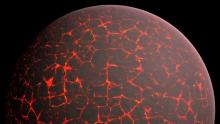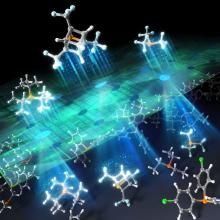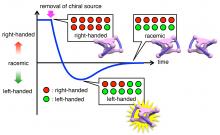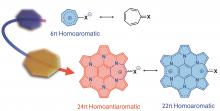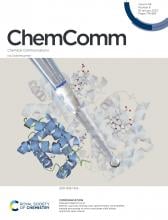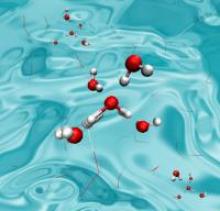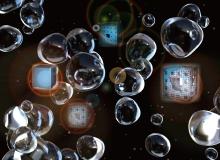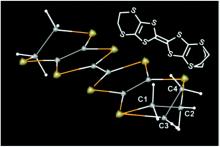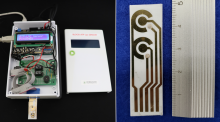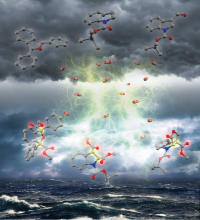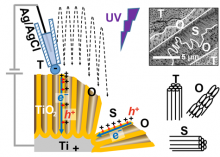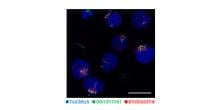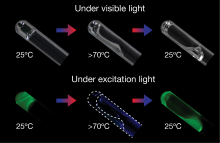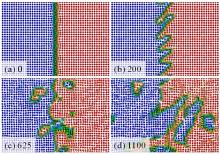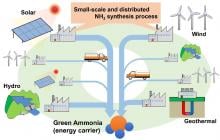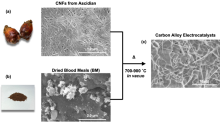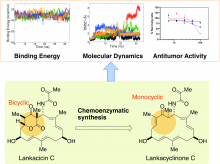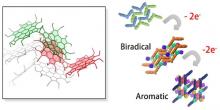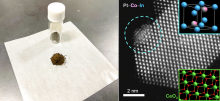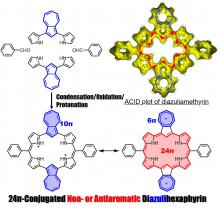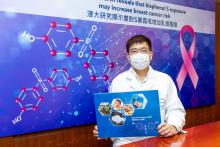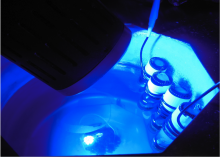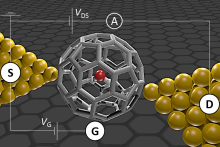Chemistry
News
15 Mar 2022
The Earth-Life Science Institute (ELSI) based at Tokyo Institute of Technology will reach a turning point this year. For the first time in its 10-year history, it will extend the scope of its initial research theme, "The Origins and Evolution of the Earth and Life", to include searching for evidence of extra-terrestrial life. ELSI’s new director, Yasuhito Sekine, told Asia Research News what they hope to achieve in the next phase and how.
15 Mar 2022
Unlike most traditional Japanese universities, the Earth-Life Science Institute (ELSI) at Tokyo Institute of Technology has created a ‘flat’ and diverse research environment. On its ten-year anniversary, Outgoing Director Kei Hirose shares what is special about the institute and the secret behind its successful management.
14 Mar 2022
Researchers aim to streamline the time- and resource-intensive process of screening ligands during catalyst design by using virtual ligands.
10 Mar 2022
Researchers at Kanazawa University report in Proceedings of the National Academy of Sciences a responsive molecular system that, through chemical reactions, inverses its chirality before becoming racemic.
09 Mar 2022
- New HPHAC analogues with an embedded nonbenzenoid aromatic ring have been synthesized.
- The newly synthesized HPHACs exhibit multistep redox properties and their dicationic species showed an aromatic nature based on macrocyclic conjugation.
- Methylation on the nonbenzenoid aromatic ring resulted in the development of "antiaromaticity".
08 Mar 2022
Researchers have developed a new method for rapid 3D imaging. Instead of having to scan repeatedly in 2D, the researchers proposed a one-scan technique that uses a light needle to process at depth and laterally.
07 Mar 2022
The Earth-Life Science Institute (ELSI) in Tokyo launches a new integrated graduate course exploring the origin and evolution of life and planets.
02 Mar 2022
An innovative sample preparation method for cellular proteomics and protein structural analysis
28 Feb 2022
Scientists developed a procedure to reproduce the double peak feature of x-ray emission spectroscopy (XES) spectra in liquid water.
27 Feb 2022
With the aid of mathematics, materials chemistry enables dimension travel, unveiling that all properties of materials are governed by their dimension.
27 Feb 2022
A Detailed comparative study on the structures and electrical properties of related insulators and superconductors
25 Feb 2022
Scientists have developed a prototype sensor that could help doctors rapidly measure adenosine triphosphate (ATP) and lactate levels in blood samples from patients, aiding in the rapid assessment of the severity of some diseases.
22 Feb 2022
Using electricity, a new method offers the possibility of recycling CO2 while also performing a notoriously difficult reaction, producing compounds potentially useful for drug development.
17 Feb 2022
In a recent study published in the journal ACS Catalysis researchers from Kanazawa University describe novel scanning electrochemical cell microscopy measurements to determine sites of photoelectrochemical activity in titanium dioxide nanotubes.
16 Feb 2022
This is a novel study that attempted to construct a pH-sensitive delivery system into T cells and their subsets using carboxy-terminal Phe- and CHex-modified dendrimers with different structures, i.e. PAMAM-CHex-Phe and PAMAM-Phe-CHex. The findings contribute to the development of nanoplatforms for direct delivery to T cells to control the functions of T cells, which play key roles in cancer immunotherapy. This is the first report on direct delivery into T cells using pH-sensitive DDS.
16 Feb 2022
Simulations have led to the fabrication of a polymer-DNA gel that could be used in tissue regeneration and robotics.
16 Feb 2022
Through numerical simulations, a researcher details the discovery of a new isolated skyrmion with a half-integer topological quantum number in the ferromagnetic phase of the magnetic quantum fluid Bose-Einstein condensate (BEC). The new skyrmion is generated by applying a spin current to a magnetic domain wall and it has an eccentric (off-center) spin singularity inside it.
14 Feb 2022
Research by Japanese scientists at Hiroshima University reveals a way to make ammonia from its constituent molecules of nitrogen and hydrogen at ambient pressure.
11 Feb 2022
Low volcanic temperature ushered in global cooling and thriving dinosaurs, Broccoli compound induces cell death in yeast, A single molecule makes big splash in quantum mechanics, Dengue virus makes mosquitos bite more often, and Asia Research News: How it all began, all in the February's Editor's Choice
09 Feb 2022
Sea pineapples are a delicacy in Japan and the Tohoku region is renowned for its extensive sea pineapple industry. Soon they might not only be fueling our appetites, but helping power our future too. A research group demonstrated that the carbonization of cellulose nanofibers within sea pineapple shells produces high-quality carbon that, when mixed with blood waste from the livestock industry, boasts electrical performances similar to that of rare metals.
31 Jan 2022
Garden soil houses a variety of bacteria and their natural byproducts — including one that may help halt tumor growth. Lankacidins are molecules that can be isolated from Strepomyces rochei, a common bacterium in soil. In addition to antimicrobial properties, a type of lankacidins, called lankacidin C, can inhibit tumor activity in various cancer cell lines, including leukemia, melanoma, ovarian and breast cancers. Lankacidin C offers a potential foundation on which to design anticancer drugs, but its structure is complicated and difficult to manipulate, according to an international research group. The same group recently identified where antitumor activity is housed on the molecule and has now used that information to simplify lankacidin as a potential starting point to engineer treatments.
28 Jan 2022
Aromaticity of the Space Surrounded by Two Aromatic Rings
27 Jan 2022
Researchers have developed an innovative catalyst for the synthesis of propylene, which has potential benefits for the chemical industry and carbon recycling.
23 Jan 2022
A ring-expanded porphyrin, diazuliamethyrin, was successfully synthesized via a “3+3” condensation method. This porphyrin showed a 24pi non- or antiaromatic character. We analyzed the optical and electronic structures using magnetic circular dichroism spectroscopy and time-dependent density functional theory calculations.
19 Jan 2022
A study led by Hong Kong Baptist University (HKBU) has revealed that different degrees of exposure to bisphenol S (BPS), an industrial chemical widely used in paper products and plastic containers, are associated with the growth and deterioration of breast tumours in a mouse model. The research results suggest the need for more in-depth and comprehensive research on the potential negative impact of BPS on human health, and the ongoing search for a safer alternative for use in industrial production may be warranted.
18 Jan 2022
A new method for creating a highly useful chemical subunit eliminates the need for precious metals, potentially leading to the sustainable production of pharmaceuticals and electronics.
10 Jan 2022
Unveiling substructures at the edge of the Galaxy, Nanodiamonds key to efficient hydrogen purification, How SARS-CoV-2 evades our immune system, A Zika hijacking with devastating impacts & Finding the right story for your audience, all in the January Editor's Choice.
06 Jan 2022
A collaborative team led by researchers from Institute of Industrial Science, The University of Tokyo uses a single water molecule in a C60 cage to probe quantum mechanics
29 Dec 2021
Giants in History: Filipina chemist María Orosa (29 November 1892–13 February 1945) fought malnutrition and food insecurity in the Philippines by devising over 700 culinary creations including Soyalac, a nutrient rich drink made from soybeans, and Darak, rice cookies packed with Vitamin B1, which could prevent beriberi disease caused by Vitamin B1 deficiency.
16 Dec 2021
In a study published in Nature Energy this month, researchers led by Kyoto University’s Institute for Integrated Cell-Material Sciences (iCeMS) describe how nanodiamond-reinforced composite membranes can purify hydrogen from its humid mixtures, making the hydrogen generation processes vastly more efficient and cost-effective.
Events
Sorry, nothing coming up for this discipline
Researchers
Sorry, nothing coming up for this discipline
Giants in history
Sorry, nothing coming up for this discipline



